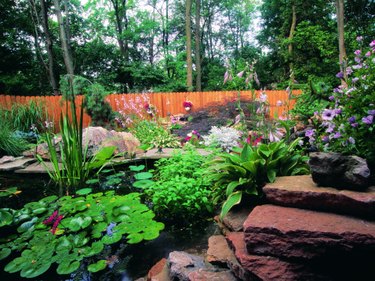
Ornamental grasses lend grace, beauty and eye-catching movement to the home landscape as the delicate fronds sway with the slightest breeze. Hameln dwarf fountain grass is a small, clumping ornamental grass that only grows 2 to 3 feet tall and bears ivory to white plumes that wave above the foliage from summer to fall. Hameln dwarf fountain grass has no serious pest or disease problems, but improper growing conditions and care can stunt or harm the plant.
Sunlight
Video of the Day
Hameln requires plenty of sunlight to produce its lovely plumes. While the plant will tolerate some shade, too much may result in Hameln refusing to flower at all. Select a planting site that gets full sunlight most or all of the day unless you live in an area that regularly experiences blistering summer heat.
Video of the Day
Water
Although it has some drought tolerance, Hameln appreciates a regular, deep drink of water. If a dry spell lasts more than a few days or the grass begins to appear parched, water the plant regularly to keep the roots moist. Hameln generally needs more water during the hottest part of the summer. The tips of the foliage may begin to turn brown and the leaves may start to curl. Water thoroughly but do not overwater. Spread an organic mulch around the base of the plant to discourage weeds and retain moisture. As a bonus, the decaying mulch releases nutrients into the soil, eliminating the need for fertilizer.
Soil
Make sure the planting site has good soil drainage. Hameln likes moist to medium-wet soil, but standing water may rot the plant's roots. The quality of the soil can vary; Hameln is a tolerant plant that can grow in a variety of soil types, including the continually moist soil found near ponds and streams.
Climate
Hameln dwarf fountain grass grows best in U.S. Department of Agriculture hardiness zones 5 through 8. Average low temperatures in zone 5 are around minus 20 degrees F. While chilly winters do not faze Hameln, the searing heat and high humidity of the deep South regions in zone 8 may be problematic, according to the University of Florida Institute of Food and Agricultural Sciences. In the warmest areas of zone 8, try planting Hameln in a part of the garden that receives some shade during the hottest part of the day.
Cutting Back and Dividing Clumps
As Hameln grows, the plant may open at the top, with the stems all falling slightly backwards in a ring. To solve this problem, divide the clump every 5 to 10 years and transplant the division. For maximum growth each year, cut Hameln back nearly to the ground in March. Hameln rarely needs fertilizer.
- University of Florida; Pennisetum Alopecuroides 'Hameln' Dwarf FountainGrass, Australian Fountain Grass; Edward F. Gilman; June 2007
- University of Vermont; Pennisetum Alopecuroides 'Hameln';
- University of Arkansas Extension: Dwarf Fountain Grass
- Floridata; Pennisetum Alopecuroides; Steve Christman; March 2004